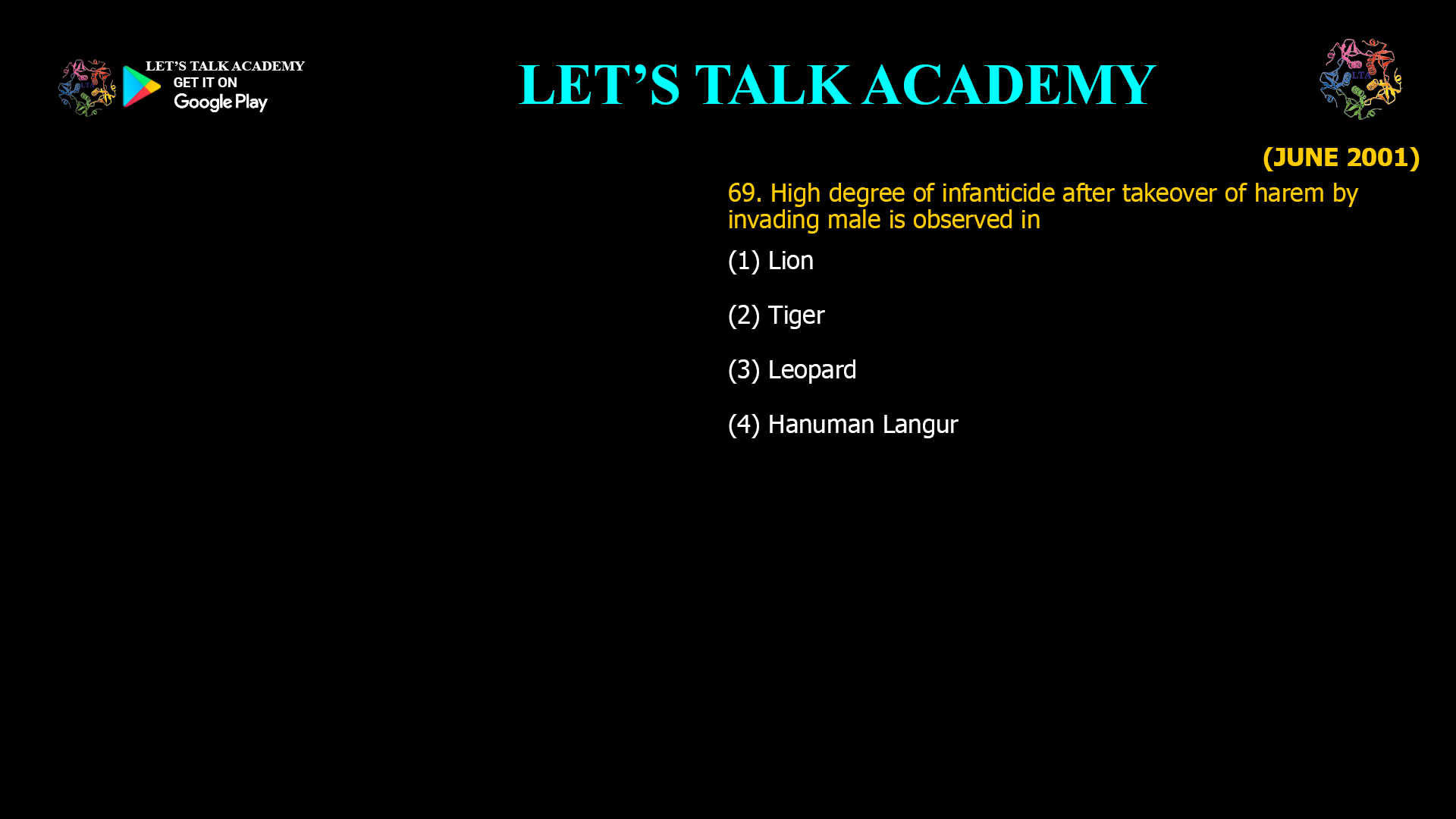- High degree of infanticide after takeover of harem by invading male is observed in
(1) Lion (2) Tiger
(3) Leopard (4) Hanuman LangurUnderstanding Infanticide in Animal Societies
Infanticide is not unique to Hanuman langurs. It has been documented in lions, leopards, and other primates. However, the frequency and social context in which it occurs among Hanuman langurs make their case particularly noteworthy. In these monkeys, infanticide is closely linked to the takeover of a group by an invading male.
Social Structure of Hanuman Langurs
Hanuman langurs, also known as gray langurs, typically live in groups consisting of one dominant male and several females with their offspring. This structure is called a unimale-multifemale group. The dominant male enjoys exclusive mating rights with the females, while subordinate or bachelor males form separate groups and wait for opportunities to challenge the resident male.
The Takeover: A Catalyst for Infanticide
When a new male or a coalition of males invades and successfully ousts the resident male, a dramatic shift occurs within the group. The incoming male seeks to maximize his reproductive success during his potentially short tenure as leader. One of the most direct ways to do this is by eliminating the offspring sired by his predecessor.
Why Does Infanticide Occur After a Takeover?
The evolutionary logic behind this behavior is rooted in reproductive biology. Female Hanuman langurs, like many mammals, do not ovulate while they are lactating. As long as they are nursing their young, they are unavailable for mating. By killing the infants, the new male ends the lactation period, causing the females to return to estrus much sooner. This allows the new male to sire his own offspring before another takeover can occur.
Evidence from the Wild
Extensive field studies have documented this pattern repeatedly. Observations in India have shown that infanticide rates spike immediately after a new male assumes control of a group. The period of infanticide is usually brief, lasting only until the new male has established dominance and the females have become receptive again. In some documented cases, up to half of all infants in a troop may be lost during these transitions.
Female Strategies to Counter Infanticide
Females are not passive in this process. They have evolved several strategies to protect their offspring:
-
Direct Defense: Mothers may attempt to physically defend their young, though this is often unsuccessful against a determined male.
-
Deceptive Behavior: Pregnant females may display mating behaviors to convince the new male that their unborn infants are his, reducing the risk of infanticide.
-
Coalitions: Sometimes, females form alliances to collectively resist the new male, though such coalitions are rare and often ineffective.
Despite these efforts, the evolutionary pressure on males to maximize their own reproductive output often outweighs the ability of females to prevent infanticide entirely.
Comparison with Other Species
While infanticide after male takeover is also observed in lions, the frequency and social context differ. In lions, new males may kill cubs after taking over a pride, but the social structure and dynamics are not identical to those of Hanuman langurs. Tigers and leopards have also been observed committing infanticide, but it is less closely tied to group takeovers and more often related to territory changes or competition.
Evolutionary Impact on Hanuman Langur Society
The high rate of infanticide has shaped the social and reproductive strategies of Hanuman langurs:
-
Short Tenures: Males rarely hold onto a group for long, increasing the urgency to reproduce quickly.
-
Female Philopatry: Females tend to remain in their natal groups, while males move between groups, often leading to repeated cycles of takeover and infanticide.
-
Behavioral Adaptations: Both sexes have developed behaviors—aggressive, defensive, and deceptive—to navigate the risks and opportunities presented by this system.
Ethical and Conservation Considerations
While infanticide may seem brutal from a human perspective, it is a natural outcome of evolutionary pressures in these societies. Understanding this behavior is crucial for conservation efforts, as disruptions to social structures—such as those caused by habitat loss or human interference—can exacerbate infanticide rates and impact population stability.
Conclusion
The Hanuman langur stands out among mammals for the high degree of infanticide observed after a harem takeover by an invading male. This behavior is a direct result of evolutionary strategies aimed at maximizing reproductive success in a competitive social environment. While females have developed some countermeasures, the cycle of takeover and infanticide remains a defining feature of Hanuman langur society. Recognizing and understanding these dynamics is essential for both scientific knowledge and effective species management.
-




1 Comment
Kajal
October 15, 2025Hanuman langurs